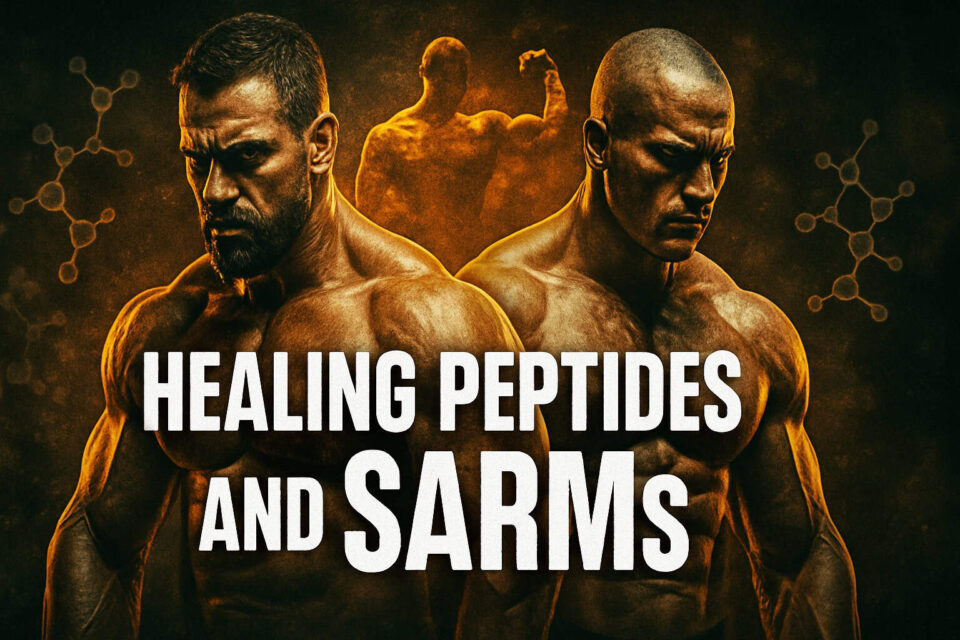The Ultimate Bodybuilder’s Guide to Healing Peptides & SARMs: How to Recover Faster and Train Harder
Injuries suck. Whether it’s a torn tendon, nagging joint pain, or just wear and tear from years under the bar, every serious lifter eventually faces downtime. But what if you could speed up the healing process, reduce inflammation, and get back to training faster — without relying solely on ibuprofen and wishful thinking?
That’s where healing peptides and certain SARMs come in. This isn’t some “biohacker blog” fluff — we’re talking compounds with clinical backing and real-world lifter feedback. The kind of stuff guys in the trenches are quietly running to bounce back from rotator cuff tears, strained hamstrings, and overuse injuries.
This guide breaks down:
- The most effective peptides and SARMs for healing
- How they work
- Dosing protocols
- Half-lives and usage timing
- Comparative effectiveness
And yes — we’ve included a full healing compound comparison table for easy reference. Whether you’re in rehab mode or building a bounce-back stack, this one’s for you.
🔬 Healing Peptides: The Fast-Track to Tissue Repair
These are short chains of amino acids that signal your body to regenerate, repair, or modulate inflammation. Some of them mimic natural growth factors; others regulate immune response. The end result? Accelerated healing and reduced pain — when used correctly.
Most Effective Healing Peptides for Lifters:
| Compound | What It Does | Dosage Range | Half-Life | Notes |
|---|---|---|---|---|
| BPC-157 | Speeds tendon, ligament, muscle healing; reduces gut inflammation | 200–500mcg 2x/day | ~4–6 hours | Can be injected near injury or taken orally |
| TB-500 | Promotes regeneration and cell migration, improves flexibility | 2–5mg/week (split) | ~2–3 days | Often stacked with BPC-157 for synergistic repair |
| GHK-Cu | Skin, soft tissue, nerve repair; collagen boosting | 1–2mg/day | ~30 minutes | Topical or subQ; often used post-surgery or for nerve trauma |
| IGF-1 LR3 | Stimulates muscle and nerve regeneration; anabolic | 20–40mcg/day (post-workout) | ~20–30 hours | Potent but must be cycled with care |
| AOD-9604 | Fat loss + cartilage repair; used for joint recovery | 300–600mcg/day | ~1–2 hours | Great add-on for lifters with joint degradation |
🧬 SARMs with Healing Potential (Yes, Some Actually Help)
Most SARMs are known for mass and strength — but a few also accelerate recovery at the musculoskeletal level. These are the ones to know:
Healing-Oriented SARMs:
| Compound | Primary Use | Healing Benefit | Dosage | Half-Life | Effectiveness Score (★ out of 5) |
| Ostarine (MK-2866) | Lean muscle, bone support | Excellent for tendon, ligament, joint healing | 10–20mg/day | ~24 hours | ★★★★★ |
| LGD-4033 (Ligandrol) | Strength and mass | Helps heal bone fractures, soft tissue | 5–10mg/day | ~24–36 hours | ★★★★☆ |
| YK-11 | Myostatin inhibitor | Promotes muscle cell maturity, helps post-injury atrophy | 5–10mg/day | ~6–10 hours | ★★★☆☆ |
| RAD-140 | Muscle mass, CNS protection | Anecdotal cognitive/mood support during injury | 10–20mg/day | ~16–20 hours | ★★☆☆☆ |
📈 Which Is Best? (Scenario-Based Recommendations)
✅ Tendon/Ligament Injury (Shoulder, Knee, Elbow)
- BPC-157 + TB-500 (inject near injury)
- Add low-dose Ostarine if training lightly
✅ Muscle Tear or Atrophy Recovery
- IGF-1 LR3 (for muscle regeneration)
- Ostarine or LGD-4033 for muscle preservation
✅ Joint Pain, Cartilage Wear, Overuse
- AOD-9604 + BPC-157 (great for aging lifters)
- Add GHK-Cu topically to joints
✅ Bone Fractures or Surgical Recovery
- LGD-4033 + BPC-157 (systemic and local repair)
- Add GHK-Cu for skin/tissue healing
⏱️ Timing & Protocol Tips
- Peptides like BPC-157 work best when injected near the injury site (subQ), 2x daily for 4+ weeks
- TB-500 should be split 2x/week; loading phase (4–5mg/week) for 4 weeks, then taper
- SARMs should be taken early morning or pre-workout for best effect
- Use Ostarine or LGD-4033 during active rehab or post-surgery when training is limited
⚠️ Real Talk: Risks, Legality & Sourcing
- Most peptides & SARMs are research chemicals, not FDA approved
- Quality control is wildly inconsistent — bloodwork and source vetting are a must
- Healing is dose and time dependent — more is NOT always better
- For severe injury, use under medical supervision if possible
🧠 Final Thoughts
If you’re a lifter dealing with injury or just want to future-proof your joints and connective tissue, this combo of healing peptides and repair-supportive SARMs is your best bet. They’re not magic. But when used correctly — with training, diet, and recovery dialed in — they can absolutely accelerate your bounce-back.
Respect the compounds. Cycle intelligently. And never train stupid just because you’re healing faster.




